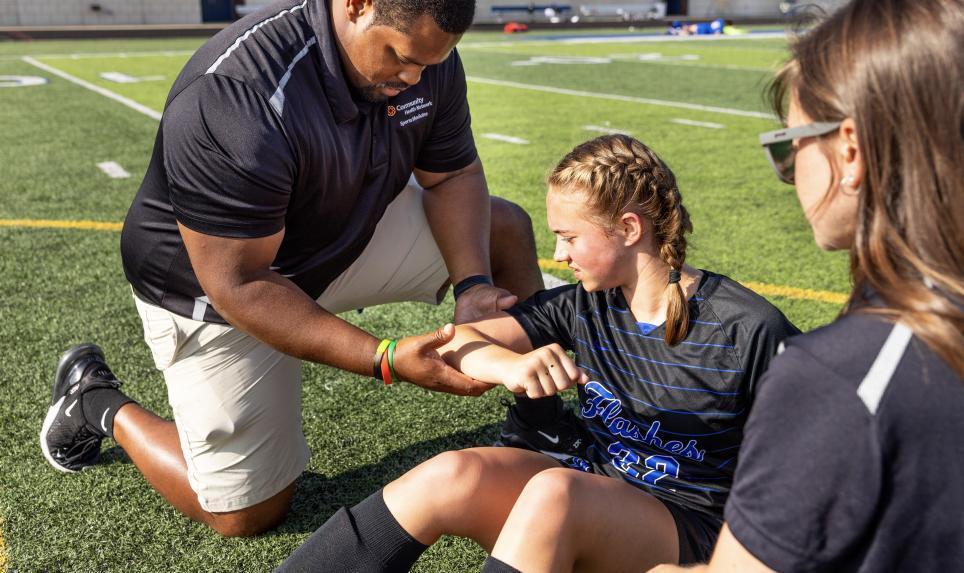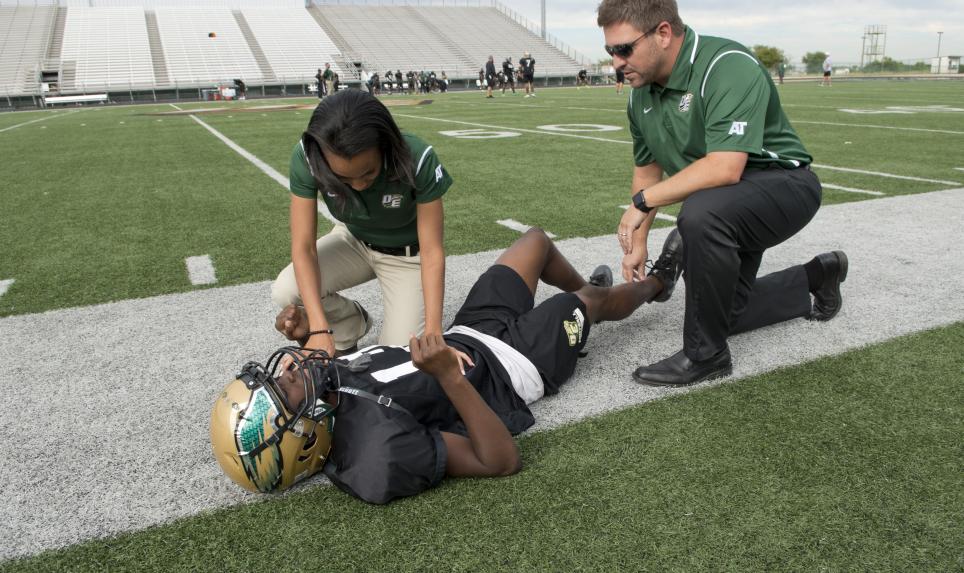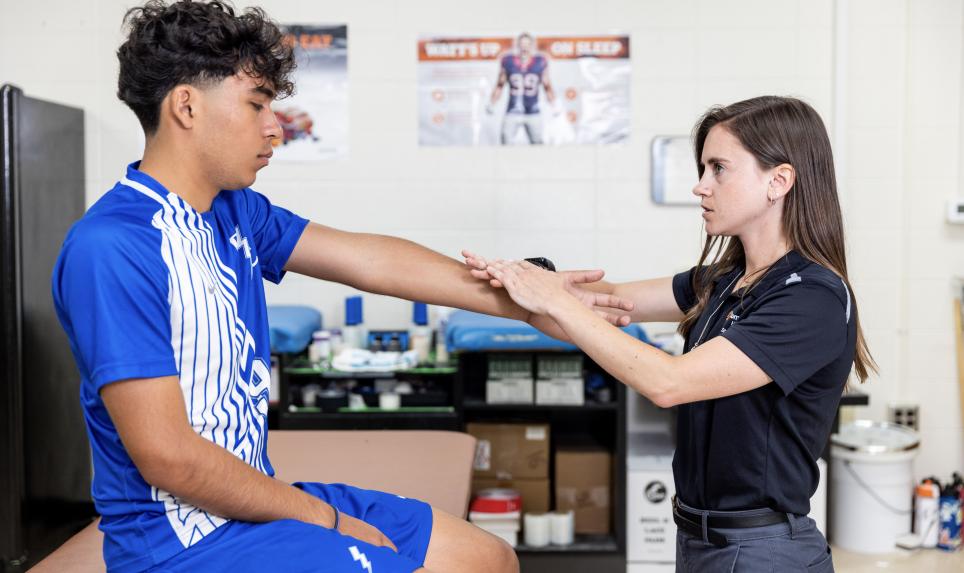When it comes to the well-being of athletes, whether in youth sports, high school teams, college athletics or professional leagues, the role of an athletic trainer (AT) is indispensable. Yet, despite their critical function, there is often confusion about what exactly what athletic trainers do, what their role is and their importance.
Understanding the Role of an Athletic Trainer
An athletic trainer is a health care professional who specializes in preventing, diagnosing and treating injuries within active populations. Some ATs work in hospitals, clinics, armed forces and public safety. For this blog though, we will concentrate on what athletic trainers do and their role working with athletes.
ATs are not the same as personal trainers, who focus primarily on fitness and exercise programs. Athletic trainers hold degrees from accredited programs and are often certified by national organizations such as the Board of Certification (BOC) in the United States. Their education covers a broad range of medical knowledge, including anatomy, physiology, nutrition, biomechanics and emergency care.
The Athletic Trainer’s Key Responsibilities
- Injury Prevention: One of the primary roles of an athletic trainer is to prevent injuries before they occur. This involves conducting pre-participation physicals, designing conditioning programs and ensuring proper biomechanics during training. Athletic trainers also educate athletes on the importance of warm-ups, stretching and proper hydration. By identifying potential risks and addressing them proactively, athletic trainers play a crucial role in keeping athletes safe.
- Immediate Care and Emergency Response: When injuries do occur, athletic trainers are often the first to respond. They are trained to provide immediate care for a wide range of injuries, from sprains and strains to concussions and fractures. In the case of severe injuries, an athletic trainer’s quick and competent action can be life-saving. They are skilled in cardiopulmonary resuscitation (CPR) and the use of automated external defibrillators (AEDs), making them irreplaceable during emergency situations.
- Injury Assessment and Diagnosis: Athletic trainers are trained to assess and diagnose injuries on the spot. Their expertise allows a determination of the severity of injury and decision on continuation of play. The immediate assessment allows for faster decisions on whether further care is needed. Athletic trainers work closely with physicians and other healthcare providers to ensure accurate diagnoses and appropriate treatment plans.
- Rehabilitation and Return to Play: The road to recovery can be long and challenging after an injury, and athletic trainers play a key role in guiding athletes through the rehabilitation process. Athletic trainers design and implement personalized rehabilitation programs that help athletes regain strength, mobility, function and confidence - all while monitoring an athlete’s progress and adjusting the rehabilitation plans as needed. An athletic trainer's goal is to ensure that athletes return to their sport safely and less likely to suffer a recurring injury.
- Education and Advocacy: Athletic trainers are educators and advocates who provide valuable information to athletes, parents, coaches and other stakeholders about injury prevention, treatment options and best practices for athletic health. They advocate for policies and practices that promote safety in sports, such as the proper use of protective equipment, adherence to concussion protocols and the implementation of heat safety measures. Their knowledge contributes to a safer and healthier sports environment for all participants.
- Collaboration with Other Healthcare Professionals: Athletic trainers are integral members of the sports medicine team. They work closely with physicians, physical therapists, nutritionists and other healthcare providers to deliver comprehensive care to athletes. This collaboration ensures that athletes receive well-rounded care that addresses all aspects of their health and well-being.
The Value of an Athletic Trainer
Having an athletic trainer on staff is not just a luxury; it’s a necessity. Here’s why:
- Improved Athlete Safety: The presence of an athletic trainer significantly reduces the risk of serious injuries. By having a professional who can assess risks, provide immediate care and manage rehabilitation, sports programs can ensure that athlete safety is prioritized.
- Faster Return to Sport: Through rehabilitation and management of injuries, athletic trainers are able to minimize the amount of time athletes miss due to injury. Getting athletes back on the playing field safely, in a time-efficient manner, is important to both athletes and coaches.
- Cost-Effective Healthcare: By preventing injuries and reducing the severity of those that do occur, athletic trainers help lower medical costs. Many times athletic trainers can manage injuries and rehabilitation in house, reducing the amount of office visits and money spent by families. This also can reduce the amount of classroom time missed due to those office visits.
- Peace of Mind for Parents and Coaches: For parents and coaches, knowing a qualified athletic trainer is present provides peace of mind. Parents can be confident their children are in good hands, while coaches can focus on developing athletes’ skills without worrying about managing injuries on their own.
- Legal Protection: In today’s litigious society, sports programs must take every precaution to protect themselves from liability. Having an athletic trainer on staff can help mitigate legal risks by ensuring that athletes receive appropriate care and that all necessary safety protocols are followed.
Conclusion: The Indispensable Role of Athletic Trainers
Athletic trainers are essential to the health and success of any sports program. Their expertise in injury prevention, immediate care, rehabilitation and education makes them invaluable assets to athletes, coaches, parents, and other stakeholders. By understanding and appreciating the role of athletic trainers, we can ensure that our sports programs are safer, more effective and more enjoyable for everyone involved. Whether at the youth, high school, college, or professional level, every athlete deserves the protection and support that only a skilled athletic trainer can provide.
Resources:
Download "What is An Athletic Trainer."
About The Authors:

Tiffany Phillips, M.Ed, LAT, ATC, is currently the Head Athletic Trainer at Grapevine High School in Grapevine, Texas. She also serves as the NATA Secondary Schools Athletic Trainers' Committee District 6 representative. Before laying roots in the secondary school setting, Phillips’ career started in the DI and DII college, as well as the NFL. When not working, she enjoys walking the dogs, reading and going to sporting events with Kamden where they can frequently be found supporting former athletes.

Megan Olson, MS, LAT, ATC, is the current District 11 representative on the NATA Secondary School Athletic Trainers’ Committee. She earned her Bachelor of Arts in Athletic Training from Luther College and her Master of Science in Athletic Training from Ohio University. Megan’s works with Gundersen Health System in Onalaska, Wis., as an outreach athletic trainer for West Salem High School. Outside of work, Megan can often be found cooking, completing home improvement projects, or taking walks with her husband and dog.


